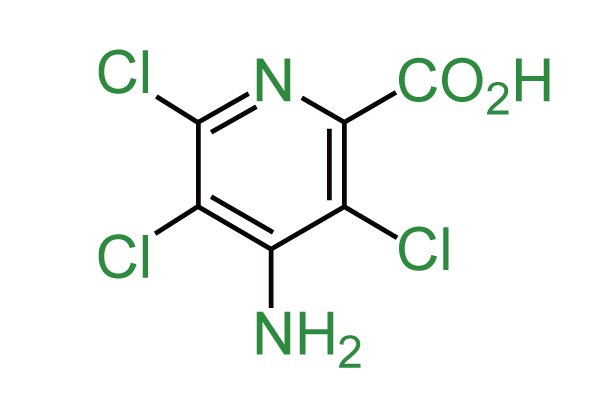- Ametryn
- Atrazine
- Bispyribac (sodium)
- Clethodim
- Clodinafop-Propargyl
- Cyhalofop-butyl
- Dicamba
- Diquat Dibromide
- Diuron
- Fenoxaprop-P-ethyl
- Flazasulfuron
- Fluazifop-P-butyl
- Flufenacet
- Fomesafen
- Glyphosate
- Haloxyfop-P-methyl
- Linuron
- Imazethapyr
- Metribuzin
- Nicosulfuron
- Oxadiazon
- Oxyfluorfen
- Paraquat
- Pendimethalin
- Picloram
- Propanil
- Pyrithiobac-sodium
- Quizalofop-p-ethyl
- Rimsulfuron
- Sulcotrione
- Tribenuron-methyl
- Tralkoxydim
- Triasulfuron
- Triclopyr
- Trifloxysulfuron-sodium
- Trifluralin
Picloram
 other name: 4-amino-3,5,6-trichloro-2-pyridinecarboxylic acid
other name: 4-amino-3,5,6-trichloro-2-pyridinecarboxylic acid
CAS No.: [ 1918-02-1 ]
Molecular Formula: C6H3Cl3N2O2
Picloram, in the pyridine family of compounds, is a systemic herbicide used for general woody plant control. It also controls a wide range of broad- leaved weeds excepting mustards (crucifers).
Picloram can be sprayed on foliage, injected into plants, applied to cut surfaces, or placed at the base of the plant where it will leach to the roots. Once absorbed by the foliage, stem, or roots, picloram is transported throughout the plant.
APPLICATIONS
Biochemistry
Growth regulator. Synthetic auxin mimic (acting like indolylacetic acid).
Mode of action
Selective systemic herbicide, absorbed rapidly by the roots and leaves, and translocated both acropetally and basipetally, accumulating in new growth.
Uses
The main use of picloram salts and esters is for the management of unwanted vegetation in rangeland, grass pastures, forestry, as well as non-crop land and rights-of-way sites such as around industrial and military installations, roads, railways, airports, under powerlines and along pipelines. In some countries, there are additional uses in rice, sugar cane, cereals and oilseed rape.
Phytotoxicity
Phytotoxic to most broad-leaved crops (except crucifers). Non-phytotoxic to established grasses, but seedling grasses may be susceptible.
Formulation types SL
Our Technical Material (TC) of Picloram have the specification as below:
| Items | Specification |
|---|---|
| Appearance | White Powder |
| Content (as Paraquat Dichloride) | 95% min. |
| Ammonia Choride | 0.5 % max. |
| Water | 1.0% max. |
GHS complaint Safety Data Sheet (SDS) for commercial product of Picloram is available uopn requested.
